Research Experience
Yulin PanMIT
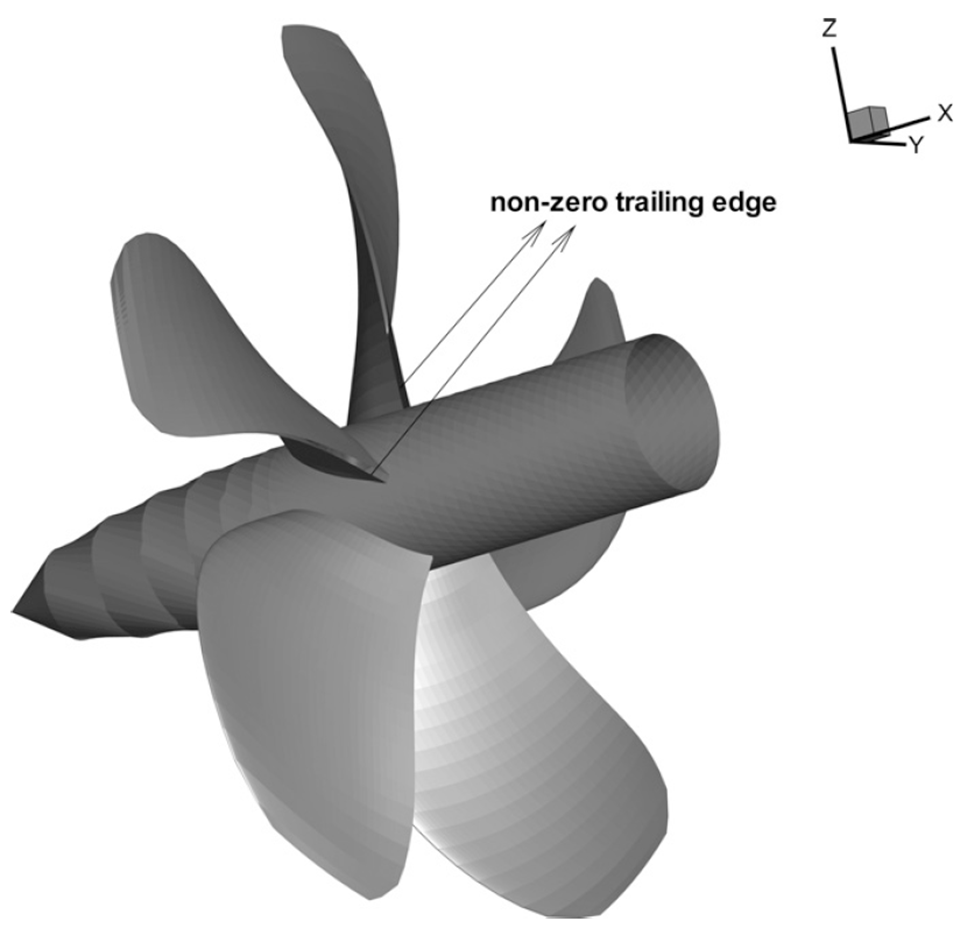
Typical propeller with non-zero trailing edge
I started my research on fluid dynamics in UT-Austin, where I worked on the modeling of propeller flows using the Boundary Element Method (BEM), advised by Prof. Spyros A. Kinnas. Compared to Navier-Stokes simulations, BEM provides a reduced-order model that is desirable for propeller design. However, the flow separation at the round (or non-zero) trailing edge of realistic propellers cannot be incorporated. To resolve this issue, I developed an iterative scheme, coupled with BEM, to model the flow separation zone by a properly extended sharp trailing edge. The predictions from the developed approach achieve favorable agreement with the experimental measurements and Navier-Stokes simulations.
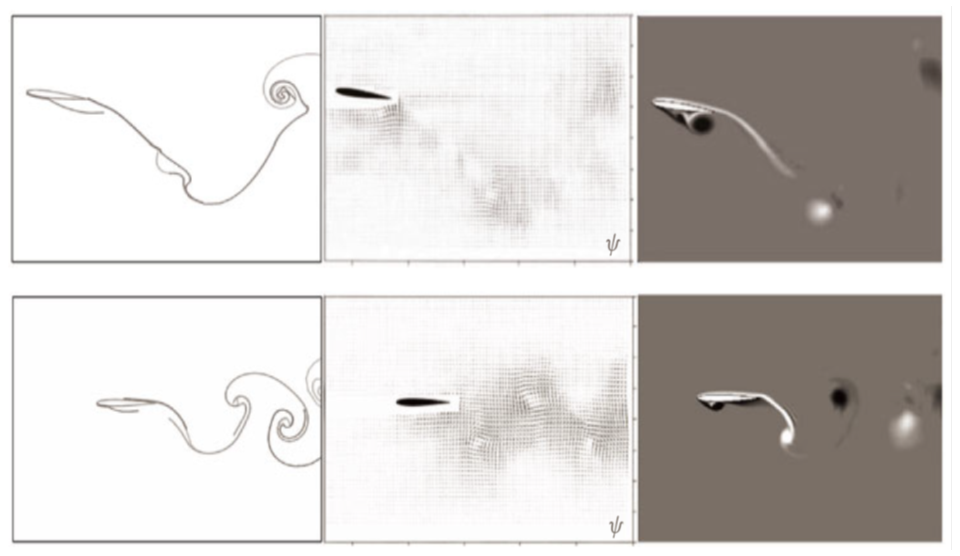
Snapshots of leading-edge and trailing-edge shed vortex structures from (left) prediction by LEV BEM; (middle) DPIV measurement; (right) Navier-Stokes simulation, for two cases.
I spent my first two years at MIT continuing research on Boundary Element Method (BEM), but with application to flapping-foil propulsion. This research topic is inspired by the locomotion of aquatic creatures employing flapping fins and appendages. I developed a numerical model based on BEM to predict the performance of flapping foils incorporating the alternating shedding of leading-edge vortices (LEV), which is a main element of difficulty in previous analysis of flapping foils with large motions. The developed method is compared with experiments, and the inclusion of LEV significantly improves the prediction, obtaining excellent agreement with measurements over a broad range of flapping motions. I further solved for the optimization of flapping motion to achieve maximum efficiency under specified thrust. The study is important for the design of flapping foils as the next-generation propulsion system for water vehicles.

Figure 1: (left) energy cascade from large to small vortices in flow turbulence; and (middle) from long to short waves in wave turbulence; (right) similar energy spectrum for flow or wave turbulence.
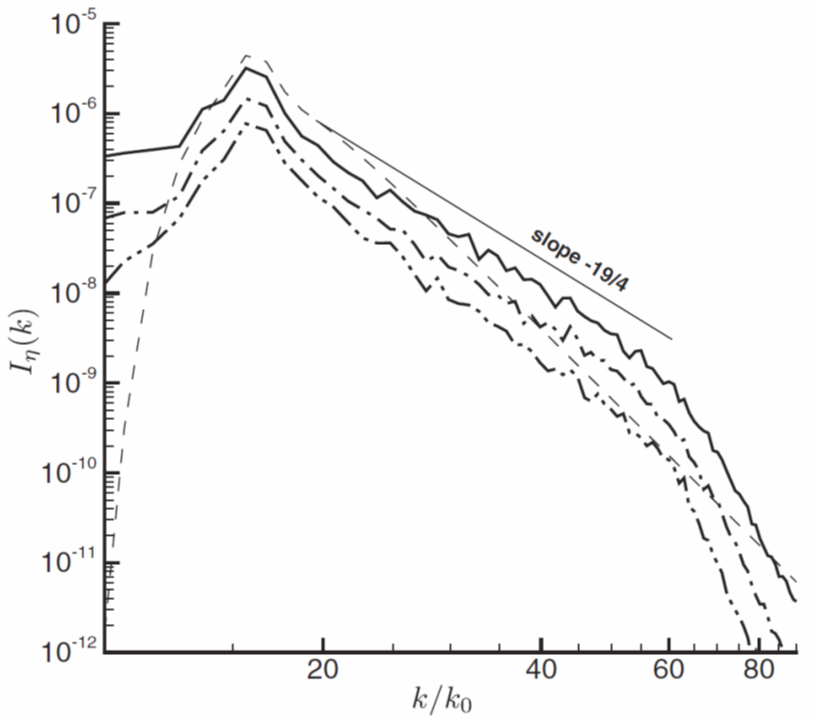
Figure 2: Typical evolution of spectrum with time predicted by the numerical simulation: Initial spectrum (dashed line); fully developed spectrum (solid line); Decayed spectra in quasi-stationary state due to dissipation (single dotted dash line and double dotted dash line). The slope corresponding to the analytical solution of -19/4 is indicated.
My research interest was then shifted to nonlinear waves, and I studied extensively on the wave turbulence theory (WTT). Developed by Zakharov (Dirac medal winner due to the theory), WTT describes the stationary field of an ensemble of waves in weakly nonlinear interactions. The equilibrium wave spectrum I(k) can be obtained from the theory as an analytical power-law solution over a range of wavenumber k, carrying an energy flux P from large to small scales. This solution can be understood in analogy with Kolmogorov’s description of the cascade process in the inertial range of turbulent flows (see figure 1 for an illustration).
My study on WTT started from capillary waves (ocean surface waves at small scales), which play an important role in the upper ocean dynamics, and physically represents a class of dispersive waves allowing triad resonance on a two-dimensional surface. In theory, I reformulated the derivation, leading to I=CP1/2k-19/4, with the Komogorov constant C=2π×6.97, corrected from the previous value of 9.85 derived by Zakharov 15 years ago. Then I established a numerical simulation of the primitive Euler equations (see figure 2 for a typical simulation), which successfully confirmed the new analytical result. This resolves a long-term debate on the value of C due to previous inconsistent analytical, numerical and experimental attempts.
With the theoretical solution confirmed, I further studied the effect of assumptions (e.g. weak nonlinearity, infinite domain) involved in the derivation. This is important in understanding the realistic spectrum. I investigated particularly the effect of a finite domain (e.g. waves in a finite tank) on the capillary wave spectrum, starting from numerical simulations. The simulations revealed that the spectrum tends to have its power-law slope steepened and energy flux decreased as the domain size decreases. These variations were found to be caused by the wavenumber discreteness due to the finite domain, which to some extent suppresses the nonlinear interactions. Inspired by these findings, I developed a theoretical model named quasi-resonant kinetic equation which describes the property of stationary spectrum in a finite domain.
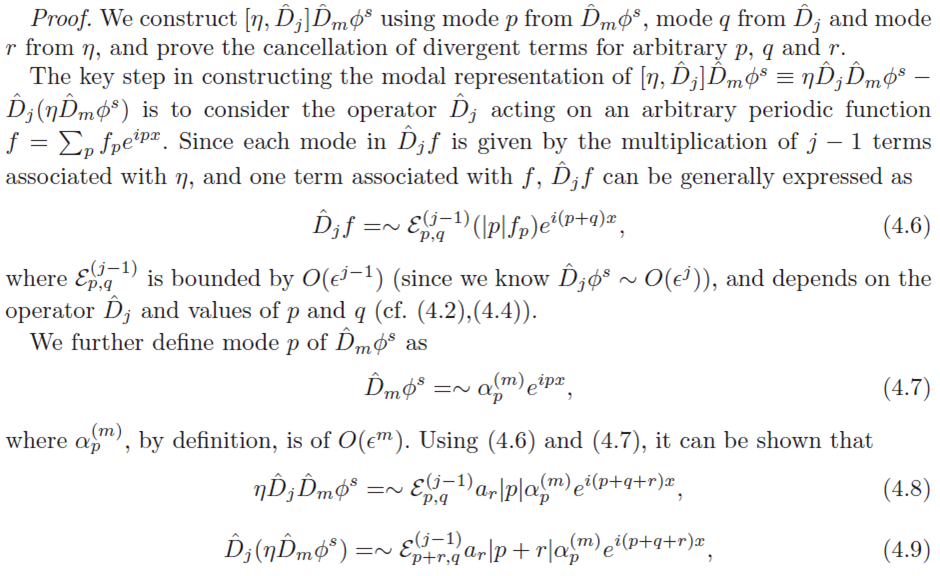
part of the proof.
In high-order analysis and simulation of surface waves using truncated Hamiltonian equations, a key procedure is to obtain the surface vertical velocity from a boundary value problem using perturbation analysis. For a multi-scale wave field, this perturbation series contains large terms proportional to the product of short-wave wavelength and long-wave amplitude. Due to this issue, there has long been doubt on the convergence of the series, resulting in the lack of resolution of the long-short wave interactions.
I provided the first theoretical proof, using mathematical induction, on the cancelation of large terms at arbitrary order of the perturbation for a multi-scale wave field. This resolves the historical issue and lays foundation on the numerical simulation of long-short wave interactions. The study also sheds light on the perturbation solution of boundary value problems in different physical contexts.
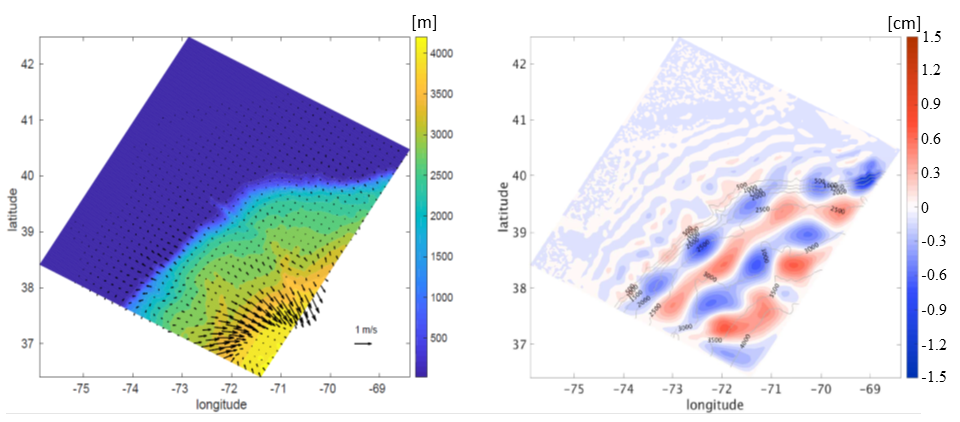
Figure 1: (left) region of the Middle Atlantic Bight, with water depth indicated by contour levels (meter) and mean flow by vectors; (right) a snapshot of the surface displacement induced by mode-1 IT.

Figure 2: schematic plot of IT propagating from a quiescent field into (a) following and (b) opposing current.
I broadened my research scope to large-scale geophysical flows during my postdoc stage at MIT. I studied the generation and propagation of internal tides (internal gravity waves at tidal frequency) in a rotational and inhomogeneous ocean background with spatially varying mean flow, buoyancy and topography. For interaction in a vertically bounded domain, the field of internal tide (IT) can be expanded using a set of modal basis functions which capture its vertical profile, with the modal amplitudes varying in the horizontal space and time.
I started by deriving the evolution equations of the modal amplitudes, including terms describing the interactions with the mean field. This provides a reduced-order model of the IT since most of its energy is contained in the low-mode waves. These equations are verified using direct simulations of the primitive equations for two regional flows around the Middle Atlantic Bight and the Palau Island (see figure 1 for an illustration of the former). Significant interactions of the IT with the mean field are physically present at the continental and insular shelf break, and the gulf stream. The modal energy budget of the IT at these regions is quantified by considering the effects of mean-flow advection, energy exchange with the mean field and topographic modal conversion.
I also considered the interaction of IT with a large-scale barotropic current for which the evolution of each vertical mode can be decoupled. Under this circumstance the derived modal evolution equation is reduced to the conservation of modal wave action, and a WKB approach is established to analyze the interaction. I derived the analytical solutions of the modulation of wavenumber and energy of a modal IT propagating into a collinear current (see figure 2 for a schematic plot). These solutions have profound implications on the propagation and dissipation of IT in the ocean.